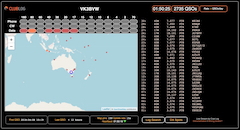 |
| Photo: AWA |
SPOTLIGHT:
BBC ASCENSION ISLAND RELAY STATION
(This post is an edited version of an article I wrote for "The World of Shortwave Listening" column of The Spectrum Monitor magazine - April 2021 issue. Further details on this excellent publication are available at www.thespectrummonitor.com)
A recent QSL card for the long-established BBC Ascension Island relay station now features some interesting information on the antennas and transmitters at this important site. Actually, it is not a standard QSL card with pretty pictures but rather a tri-folded paper verification. And both sides of this QSL are packed with facts about the island, the transmitters and the antennas. If only all QSLs contained this type of data on their transmitting facilities!
Encompass Digital Media now manages the BBC relay station at Ascension (South Atlantic Ocean) along with Woofferton (England) and Dhabayya (United Arab Emirates). Ascension is a lump of volcanic rock located at S7°53’53.1672” and W14° 22’37.4124”, about halfway between Brazil and the coast of West Africa. Input those coordinates into Google Maps and you will be taken to a dot in the Atlantic Ocean. Zoom in and you will see a village called Georgetown, a NASA tracking station, a Royal Air Force station, and the rather ominous sounding Dead Man’s Beach Cemetery! At the northern tip of the island is the BBC South Atlantic Relay Station, where, if you zoom in even further, you can glimpse the outline of the antenna structures.
So, if we visited Ascension, what would we find at this BBC antenna farm? Well, our folding QSL tells us that when first established, 20 arrays were constructed on ten masts, ranging in height between 46 and 99 meters (approx 150 to 325 feet). Each array can cover two adjacent shortwave bands and has a typical gain of 15dB.
In 1989, another five self-supporting towers were added, the tallest being 126 meters (413 feet) high. Suspended between them are four antenna arrays. Three of these can cover two bands, and one covers three bands. All the arrays at this site can provide forward and reverse beaming of transmissions in wide arcs, resulting in an expansive range of directional capabilities.
Construction of the station was completed in 1967. Transmitters have been replaced over the years, and the current installation sees four RIZ 250 kW AMC transmitters. In addition, there are two older Marconi BD272 250kW transmitters still in operation. However, these have limited use of around two hours per day due to the improved efficiency of the newer RIZ senders. Interestingly, the QSL points out that these RIZ transmitters use only one large valve located on the output stage. By comparison, the Marconi units use four large valves and more than 20 smaller valves to provide amplification.
 |
| Photo: AWA |
Prior to May 2011, the station was manned 24 hours a day. However, it now operates mostly unmanned due to the implementation of an automatic control system that requires no intervention from staff to execute the daily transmission schedule. Instead, a team of engineers work at the site carrying out routine maintenance and repairs.
The BBC Atlantic Relay Station also has its own power station, providing electricity for not only the transmitters but much of the island’s 880 inhabitants. Although diesel generators provide the bulk of electricity requirements, five wind turbines have been erected around the power station, each capable of supplying 300kW to the grid. On a good day, the wind generators produce around 40% of the island’s power demands. And as there is no natural source of fresh water on the island, the power station also incorporates a freshwater treatment plant, converting seawater into safe drinking water by reverse osmosis.
Currently, Ascension Island is the ideal site for the BBC’s transmissions into west and central Africa and previously into South America. Although the station does not offer strong reception here in Australia, signals into North America and parts of Europe are reported as being generally well heard. You can read more about this unique site in the South Atlantic Ocean by heading to the Encompass Digital Media website and checking out Ascension Island – An Island Radio Transmission Station and Spotlight on Ascension Island.
The English schedule for this A21 transmission season (March 28 to October 30) includes the following:
73 and good DX to you all!
Rob Wagner VK3BVW
Radio stations featured in the Spotlight series
Note: This series covers more than ten years, so the frequencies and times mentioned in some of the articles may be out-of-date. Refer to the latest schedule information for current operating times.
SPOTLIGHT: SICHUAN ETHNIC RADIO
SPOTLIGHT: THE VOICE OF JINLING
SPOTLIGHT: TAJIKISTAN ON SHORTWAVE
SPOTLIGHT: TRANS WORLD RADIO AFRICA
SPOTLIGHT: BBC ASCENSION ISLAND RELAY STATION
SPOTLIGHT: JAPAN’S PRIVATE SHORTWAVE STATION
SPOTLIGHT: VOICE OF BEIBU BAY RADIO
SPOTLIGHT: WONDERFUL WOOFFERTON
SPOTLIGHT: RADIO MIRAYA - THE SOUND OF SUDAN! (Sadly, this station no longer operates on shortwave)
SPOTLIGHT: KYRGYZSTAN ON SHORTWAVE
CLICK HERE for VK3BVW Live Stream (Clublog)
| QRZ callsign lookup: |
© Rob Wagner, Mount Evelyn DX Report, and contributors 2012-2025






No comments:
Post a Comment